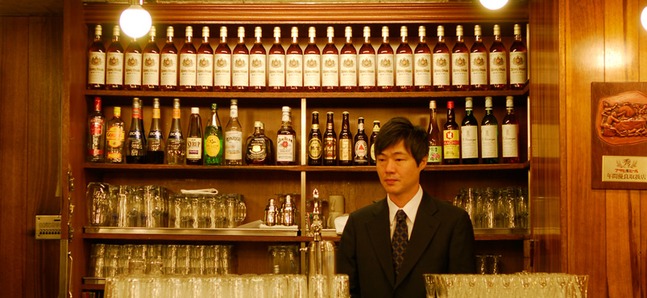
Posted: Fri Sep 25 2009
If you like beer, whisky or sake, you’re in for a treat in Tokyo. It’s not just the quality and range of these three tipples that impress, it’s also the extraordinary number of opportunities you’ll have to indulge your taste buds. You won’t look out of place sinking a drink in a cinema, bowling alley, temple grounds or hot spring.
If you’re looking for the finest malts, rums, tequilas or wines, you’ll find them in this metropolis. But be warned: you’ll pay through the nose for them.
Smart bar or rowdy dive?
For the cost-conscious, there is the curious option of happoushu and the drinks known locally as ‘third beers’. To circumvent the tax on beer, these brews are created with lower levels of malt. As the government attempts to catch up by lowering the percentage of malt in its definition of beer, the breweries respond with less malty brews. Currently, the malt content of the cheaper options lies between zero and 25 per cent. The drinks have their fans, but only the dullest of taste buds would mistake them for real beer.
Despite the vast number of drinking spots, defining a ‘bar’ is quite a challenge. Drinking and eating are such inseparable activities for Tokyoites that some of the best boozing spots are technically restaurants - such as the TY Harbor Brewery - and many of the places listed below have impressive food menus. Even venues that consider themselves strictly bars will probably serve a mandatory snack called otoshi. This could be a handful of peanuts, a bowl of potato salad or something far less identifiable. Expect to pay 500-1,500 depending on the area and style of bar. The same dish is served to every customer - a service that is considered more sophisticated than demanding an entrance fee. This system can make bar-hopping an expensive pursuit unless you look for the ‘no charge’ signs (in English) posted outside most free bars.
The quintessential eating and drinking experience is the izakaya. Ranging from rowdy dives to designer settings, these bars offer giant jugs of beer and a wide selection of reasonably priced Japanese fare. Other popular options include the ever-increasing number of Irish and English pubs (the best ones are What the Dickens and the Meguro Tavern). Most serve Guinness on tap and have no otoshi charge.
Location, location, location
Tokyoites love their tiny, crumbling drinking dens too. Top of the list are the venues in the Golden Gai area (Golden Gai); but Nonbei Yokocho (Drinking Alley) - a row of tiny bars under the train tracks just opposite Shibuya Station’s Hachiko exit - and the Albatross in Shinjuku’s Omoide Yokocho (which is more colloquially known as Shonben Yokocho, or ‘Piss Alley’) are also well worth a try.
Each area of the city has a discernible character reflected in its bars. Harajuku, Aoyama and Nishi-Azabu are the best places for sleek lounges and designer interiors. Roppongi, meanwhile, offers the complete opposite: tatty, noisy joints with drinks as cheap as the pick-up lines you’ll hear within. In Shibuya and outlying Shimo-Kitazawa you’ll find quaint, affordable bars, while Ginza is the place to test your credit limit.
When a pub is not a pub
Take care if you see the words ‘pub’ or ‘snack’ outside a small Japanese bar; these two words are misleading for foreigners in search of a drink. Such places often turn out to be tamer versions of hostess bars, where the staff will drink away merrily on your bar tab. Prices are rarely displayed, so if you are not the guest of a regular customer you can expect to pay an arbitrary and sky-high sum at the end of the night.
But this is an exception. In general, you’ll find Tokyo’s bars welcoming, even if you don’t speak the language. Generous licensing laws mean that many places don’t close until the trains begin running at 5am - which means the first few trains of the day often carry a jumble of sleepy-eyed salarymen heading for work, and baggy-eyed soaks (who may or may not also be office-bound). Fortunately, public drunkenness is treated with tolerance.
Tokyo City Guide (Edition 5)
Tweets
- About Us |
- Work for Time Out |
- Send us info |
- Advertising |
- Mobile edition |
- Terms & Conditions |
- Privacy policy |
- Contact Us
Copyright © 2014 Time Out Tokyo










Add your comment